Was Reconstruction a success?
The Reconstruction Era lasted from the end of the Civil War in 1865 to 1877. Its main focus was on bringing the southern states back into full political participation in the Union, guaranteeing rights to former slaves and defining new relationships between African Americans and whites. While very little fighting occurred on Iowa soil and Iowa had never legalized slavery, black migration of former slaves into the region and the national focus on civil rights forced Iowa to reconsider its own racial relations.
Amending the U.S. Constitution during Reconstruction
When southern states seceded from the Union, they withdrew their representatives from Congress, leaving both the Senate and the House under the control of the North. While most white Americans still held views that whites were superior to African Americans and were not yet ready to integrate society, many were sympathetic to the plight of freed slaves and wanted to promote their welfare. On the political front, Republicans were eager to give African Americans the right to vote because they anticipated that African Americans would strongly support them at the polls.
To achieve these goals, Republicans needed to amend the U.S. Constitution, a process that requires approval of two-thirds of each chamber of Congress and ratification by three-fourths of the states. Republicans felt an urgency to get these measures approved before southern congressmen returned to Washington, D.C., who could block the process. In 1865, Congress passed and states approved the 13th Amendment to the Constitution prohibiting slavery. In 1868, the 14th Amendment was ratified granting "equal protection of the law" and "due process" to all citizens to prevent southern states from passing laws that would discriminate against African Americans.
Constitutional Changes in Iowa
The Iowa legislature, controlled by Republicans, approved both amendments. Even though there was some opposition to measures that looked as if they were moving toward racial equality, Iowa Republicans realized they could not impose on the South restrictions that they were not willing to support at home. Before the Civil War, African Americans were denied the right to vote in northern as well as southern states. Iowa was no exception. The 1857 Constitution restricted suffrage to white males 21 years of age and over. Changing the state constitution required an affirmative vote on a referendum. In 1868, two years before the 15th Amendment prohibited denying the vote to anyone based on "race, color or previous condition of servitude" (slavery), the Iowa legislature submitted to the voters (all white males at the time) an amendment to strike the word "white" from voting requirements. The measure won a majority, and African-American males in Iowa could vote. In 1870, when the 15th Amendment came to the states ensuring African-American suffrage nationwide, Iowa became the 29th state to approve it, providing the final state necessary for passage.
The suffrage amendment was controversial on several fronts. Many white voters, primarily Democrats, opposed measures that brought African Americans more fully into mainstream society. Advocates for women’s suffrage were very disappointed that the measure stopped with African Americans — male only — suffrage, leaving all women out of the voter pool. Some Republican leaders urged the suffragists to wait their turn: "This is the black men's hour." And wait the women did. Women did not achieve full suffrage for another half century.
Race Relations in Iowa
There were other legal developments on race relations. In 1867, Susan Clark, a African-American youth in Muscatine, was denied admission to the public school on account of her race. Her father, Alexander Clark, challenged the policy in a case that went to the Iowa Supreme Court, which ruled in her favor. The Iowa Constitution granted the responsibility to the Board of Education to "provide for the education of all the youths of the State." The Court ruled that "all" meant all with no authority to deny education to any based on race. In another case, the Supreme Court ruled that there could be no discrimination based on race in public accommodations like railroads and steamboats. In practice, however, the laws were unevenly enforced.
Union soldiers continued to enforce law and order in the South until 1877. During those years and after, Iowa confronted new challenges to the American commitment that "all are created equal" as more African Americans migrated to river and southeastern Iowa cities and to Des Moines. While Iowa can be proud of several major steps toward equality, racial attitudes of most white Iowans of the period continued to oppose full integration.
Supporting Questions
How did the presidential election of 1876 end Reconstruction?
- "Shall We Call Home Our Troops? We Intend to Beat the Negro in the Battle of Life & Defeat Means One Thing — Extermination," 1875 (Political Cartoon)
- "A Speech from Gov. Hayes" Newspaper Article, November 9, 1876 (Document)
- "A Truce," 1877 (Political Cartoon)
- "The Political Farce of 1876," 1877 (Political Cartoon)
- "An Act To Provide For And Regulate The Counting Of Votes For President And Vice-President..." January 29, 1877 (Document)
- "The 'Strong' Government 1869-1877 -- The 'Weak' Government 1877-1881," 1880 (Political Cartoon)
How did the U.S. Supreme Court originally interpret the Constitution's Reconstruction amendments?
- U.S. Supreme Court: Slaughterhouse Cases, 1872 (Document)
- U.S. Supreme Court: United States v. Cruikshank et al., 1876 (Document)
- U.S. Supreme Court: Civil Rights Cases, 1883 (Document)
- Plessy v. Ferguson Opinions, March 4, 1956 (Video)
How did the South restore white supremacy after the fall of Reconstruction?
- Suppressing the African-American Vote
- Segregation
- Restricting Employment
- Migration (Colonization)
- Lynching
How did African Americans fight for the basic rights of citizenship granted by the Reconstruction amendments?
- Migration
- Applying Pressure to Elected Officials
- Using the Ballot
- Booker T. Washington and W.E.B. DuBois
- Organizing the Public
| Reconstruction and Its Impact Source Set Teaching Guide |
| Printable Image and Document Guide |
"Lynchings by States and Counties in the United States, 1900-1931," ca. 1931
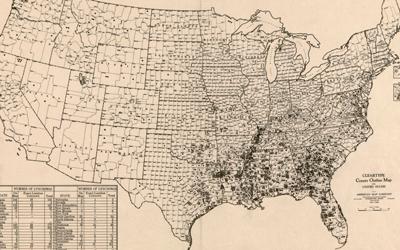
Description
This 1931 map, based on data collected by the Tuskegee Institute, depicted lynchings per county throughout the entire United States between 1900 and 1931. In the bottom left-hand corner of the map, a table can be found that compares lynchings by state.
Letter from Cleveland Gailliard of Mobile, Alabama, to the Bethlehem Baptist Association in Chicago, Illinois, April 1, 1917
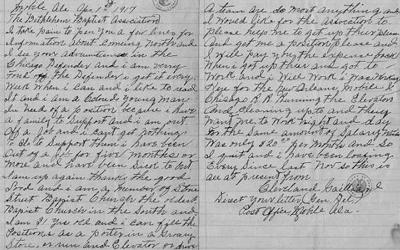
Description
The Chicago Defender, a weekly newspaper in Chicago, Illinois, was successful in encouraging African Americans to migrate from the South to the city, often listing names of churches and other organizations to whom they could write for help. As a result,…
"Open Letter to President (William) McKinley by Colored People of Massachusetts," October 3, 1899

Description
This document is an open letter from prominent African-American citizens of Boston to President William McKinley protesting presidential inaction and toleration of racial prejudice, discrimination and violence against African Americans in the South. The letter was sent…
“A New Slavery!” Newspaper Article, September 21, 1900
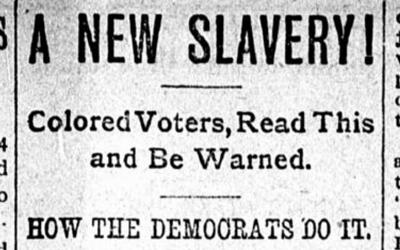
Description
Printed in the September 21, 1900, edition of the Iowa State Bystander, an African-American newspaper published in Des Moines, Iowa, a warning was given to African-American voters in West Virginia about the dangers of voting for the Democratic Party in the upcoming election…
Broadside Calling Out American Senators Who Voted Against the Dyer Anti-Lynching Bill, 1922
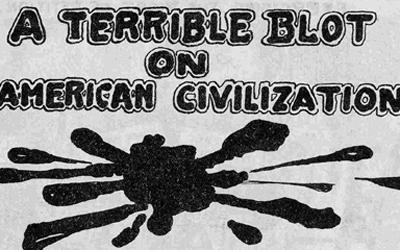
Description
The Dyer Anti-Lynching Bill, proposed by Missouri Republican Representative Leonidas C. Dyer, classified lynching as a federal felony, which would have given the federal government authority to prosecute lynching cases at a time when state and local authorities rarely did.…
Booker T. Washington's Atlanta Exposition Speech, September 18, 1895
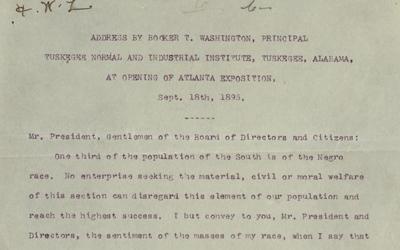
Description
On September 18, 1895, Booker T. Washington was selected to give a speech that would open the Cotton States and International Exposition in Atlanta, Georgia. The speech, which is often referred to as the "Atlanta Compromise," was the first speech given by an African…
W.E.B. Du Bois: A Recorded Autobiography, 1961

Description
The pioneer civil rights leader, scholar and author W. E. B. Du Bois recorded an autobiographical interview for Folkways Records in 1961. In this excerpt, Du Bois related the experience that turned him into an activist, his criticism of Booker T. Washington and the…
"Prof. Washington Speaks Boldly" Newspaper Article, March 5, 1904
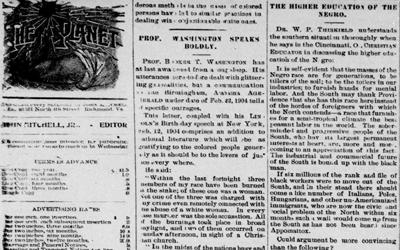
Description
The Richmond Planet, a newspaper in Virginia, re-published an open letter written by Booker T. Washington on March 5, 1904. In it, he protested lynchings and lack of trials for African Americans accused of murder in the South, warned about…
"Street Automobile Line," Newspaper Article, September 29, 1905
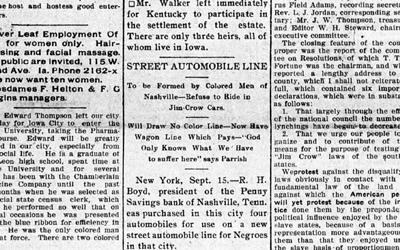
Description
In its September 29, 1905, edition, the Iowa State Bystander published an article that reported the establishment of a new street automobile line by African Americans in Nashville, Tennessee. It was created as a way to boycott the city's Jim Crow streetcar laws…
Platform Adopted by the National Negro Committee, 1909
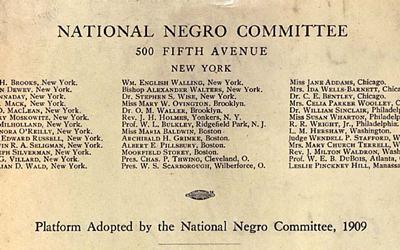
Description
William English Walling’s exposé about a bloody race riot in Springfield, Illinois, Abraham Lincoln’s hometown and burial site, resulted in the assembly of an interracial group to discuss proposals for an organization that would advocate the civil and political rights of…
"Shall We Call Home Our Troops? We Intend to Beat the Negro in the Battle of Life & Defeat Means One Thing — Extermination," 1875
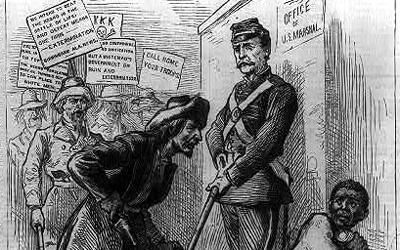
Description
In this 1875 image published in the Birmingham (Alabama) News and titled, "Shall we call home our troops? We intend to beat the negro in the battle of life & defeat means one thing--EXTERMINATION," a group of five Southern…
"A Speech from Gov. Hayes" Newspaper Article, November 9, 1876

Description
Two days after the election of 1876 between Rutherford B. Hayes, Republican governor of Ohio, and Samuel J. Tilden, Democratic governor of New York, the National Republican, a Washington, D.C. newspaper that supported the Republican Party, published reports from…
"A Truce," 1877
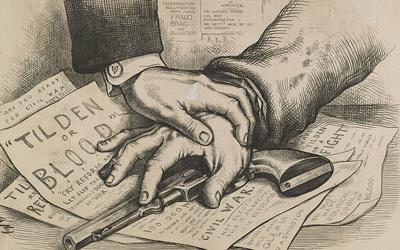
Description
In its February 17, 1877, edition, Harper’s Weekly published an illustration by Thomas Nast that depicted what he hoped would emerge from the electoral commission created by Congress at the end of January. While many in the country feared another civil war, Nast…
"The Political Farce of 1876," 1877

Description
This political cartoon was created after the electoral commission awarded Republican candidate Rutherford B. Hayes all 19 disputed electoral votes, and in turn, the presidency. This lithograph criticized the four members of the Louisiana election board and the…
"An Act To Provide For And Regulate The Counting Of Votes For President And Vice-President..." January 29, 1877
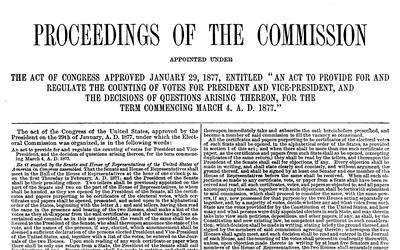
Description
Soon after election day, it was clear the Democratic candidate, Samuel J. Tilden, had secured 184 of the 185 electoral votes needed to win the presidency. Nineteen electoral votes from Florida, Louisiana and South Carolina remained disputed because rival Democratic and…
"The 'Strong' Government 1869-1877 -- The 'Weak' Government 1877-1881," 1880
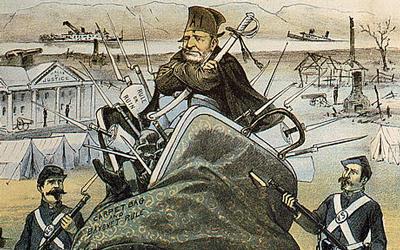
Description
In this two-part cartoon from 1880, "The Solid South" is seen struggling under the "Carpet Bag and Bayonet Rule" of the "Strong" United States government, led by President Ulysses S. Grant, who is seen riding among bayonets with an escort of two federal soldiers. In the…
U.S. Supreme Court: Slaughterhouse Cases, 1872

Description
In March 1869, the Louisiana state legislature enacted a law granting a monopoly to the Crescent City Livestock Landing and Slaughterhouse Company to slaughter animals in the New Orleans area. The goal was to eliminate the waste runoff that collected in the city from…
U.S. Supreme Court: United States v. Cruikshank et al., 1876
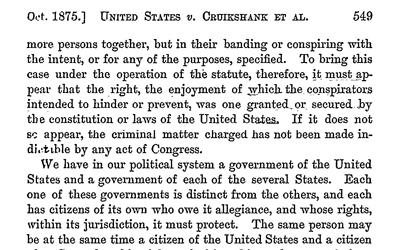
Description
In what would become known as the Colfax Massacre, on April 13, 1873, a riot broke out in Grant Parish, Louisiana between armed whites and African Americans. In the end, over 100 African Americans were killed in cold blood. Two African-American men, Levi Nelson and…
U.S. Supreme Court: Civil Rights Cases, 1883
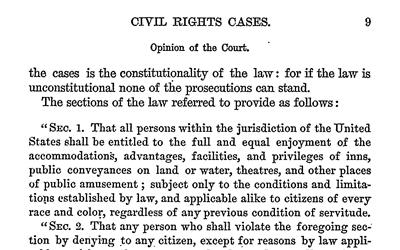
Description
The Civil Rights Cases of 1883 combined five different cases that revolved around the 1875 Civil Rights Act, which guaranteed all persons the enjoyment of transportation facilities, in hotels and inns and in theaters and places of public amusement regardless of race, color…
Plessy v. Ferguson Opinions, March 4, 1956

Description
In Plessy v. Ferguson, the U.S. Supreme Court considered the constitutionality of an 1890 Louisiana law that required railway companies to provide equal, but separate accommodations for white and African American passengers either with separate cars or by dividing a car…
"Death at the polls, and free from 'federal interference'," 1879
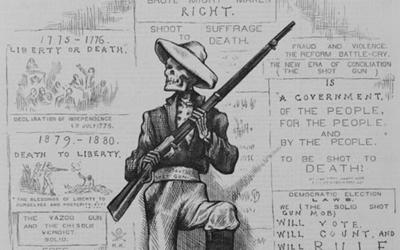
Description
Found on the cover of Harper’s Weekly on October 18, 1879, was Thomas Nast's image portraying a skeleton labeled "solid Southern shot gun" at a polling station holding a shotgun with one foot standing atop a glass bowl labeled "Suffrage" and "Liberty."…
"Congress - 14th Amendment 2nd section," 1902
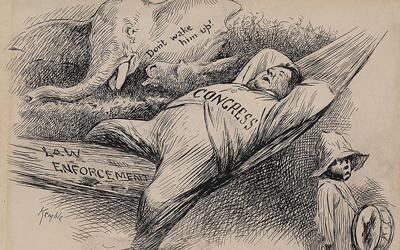
Description
This 1902 political cartoon by Edward Windsor Kemble depicted Congress as a fat man asleep in a hammock labeled "Law Enforcement" while a broken gun labeled "14th Amendment, 2nd Section" laid below him. A young African-American boy stood nearby holding a drum, but an…
Anti-Lynching Committee Report, January 21, 1912
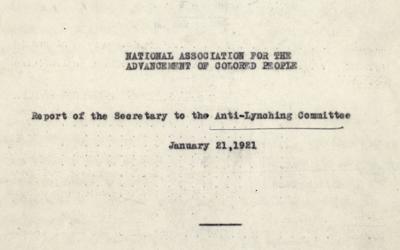
Description
Election day violence in 1920 in Ocoee, Florida, was discussed in this excerpt of the National Association for the Advancement of Colored People's (NAACP) Anti-Lynching Committee Report. After investigating the aftermath of the day's mob violence for himself, the assistant…
"What a Colored Man Should Do To Vote," Date Unknown

Description
Published by Philadelphia's E.A. Wright, this booklet helped African Americans living in the South navigate the voting requirements of their particular states. Also provided was a brief commentary on the importance of voting and the right to vote as well as general advice…
"The 'Jim Crow' Car" Poem, September 15, 1900
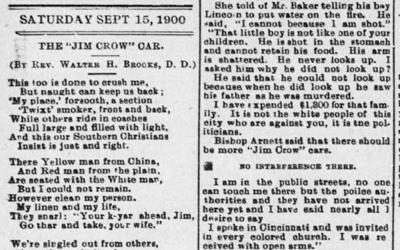
Description
The September 15, 1900, edition of the Richmond Planet (Virginia) published this poem by Reverend Walter H. Brooks, which brought to life the emotional and psychological impact of segregated rail cars on African-American passengers.
"Kentucky's Idea of Education" Newspaper Article, February 22, 1904
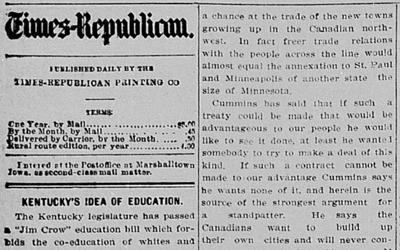
Description
On November 13, 1902, the Marshalltown Evening-Times Republican commented on a bill passed by Kentucky’s legislature, which called for the segregation of public schools. The paper was outraged and took special notice of the impact the bill would have on Berea…
"The Lessons of the Hour" Speech by Frederick Douglass, January 9, 1894
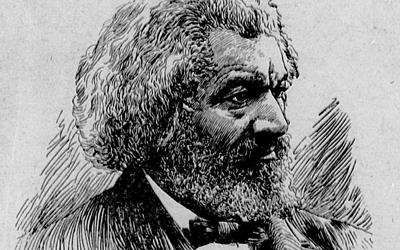
Description
On January 9, 1894, at Washington, D.C.'s, Metropolitan African Methodist Episcopal Church, Frederick Douglass delivered his "The Lessons of the Hour" speech, which addressed the often referred to "Negro problem" of the time. Refusing to believe that African Americans were…
"Will You Ever Give the Colored Race A Show," 1898
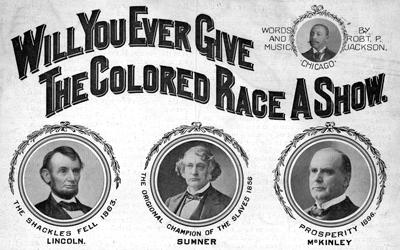
Description
Before revealing the lyrics to his August 1898 song, "Will You Ever Give the Colored Race a Show," Robert P. Jackson expressed in writing his frustration over the inability of African Americans to secure respectable jobs and promotions. This frustration was directed both at…
"Negroes to the Philippines" Newspaper Article, February 1903

Description
In February 1903, The Informer, a newspaper published in Urbana, Ohio, reported on Alabama Senator John T. Morgan's proposed plan for colonizing America's African-American population in the Philippines, which was an American colony at the time. The article…
"Lynch Law in Georgia," June 20, 1899
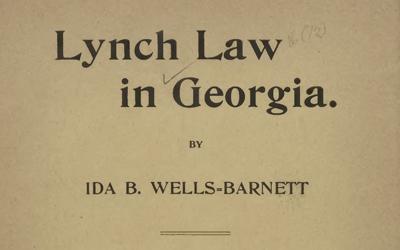
Description
Ida B. Wells-Barnett published "Lynch Law in Georgia" on June 20, 1899, to raise public awareness about white racism and violence in the South, particularly with the act of lynching. Through the accounts of two major Georgia newspapers and her own…
"Taken From Court Room and Burned" - The Lynching of Jesse Washington, May 15, 1916 (Warning: Graphic Image)

Description
This article, found on the front page of the May 15, 1916, Marshalltown Evening-Times Republican, described the capture and lynching of Jesse Washington. Washington was an 18-year-old African-American man who was convicted for the murder of a white woman near Waco…
Silent Protest Parade in New York City Against the East St. Louis Riots, July 28, 1917
![Silent protest parade in New York [City] against the East St. Louis riots, 1917 Silent protest parade in New York [City] against the East St. Louis riots, 1917](/sites/default/files/styles/large/public/education/primary-source-previews/history-education-pss-areconstruction-silent-preview.jpg?itok=AgFod_ha)
Description
Between July 1-3, 1917, violent riots exploded in East St. Louis, Illinois, resulting in the destruction of hundreds of African-American homes and businesses and the deaths of at least 39 African Americans. The National Association for the Advancement of Colored People…
Additional Resources
- "The Disputed Presidential Election of 1876" from Digital History
This reading provides background information related to the presidential election of 1876, the electoral college controversy that followed, its resolution and its impact on Reconstruction. - "Slaughterhouse Cases (1873)" from The Supreme Court PBS Documentary Series
This reading provides an explanation of the events leading up to the "Slaughterhouse" case and the U.S. Supreme Court's decision. - U.S. v. Cruikshank (1875): This online resource from Encyclopedia.com is an overview of the important U.S. Supreme Court case, U.S. v. Cruikshank. This was one of the earliest Supreme Court cases to deal with the application of the Bill of Rights to state governments following the adoption of the 14th Amendment.
- "Civil Rights Cases" Video Excerpt from The Supreme Court PBS Documentary Series
This almost 7-minute video clip emphasizes the dissent of Justice John Marshall Harlan, the only dissenter in both the Civil Rights Cases (1883) and Plessy v. Ferguson (1896). His dissents eventually served as the template for the Supreme Court's majority opinions regarding civil rights beginning in the mid-1950s. - "Jim Crow in America" Primary Source Set Teacher's Guide
This Library of Congress resource provides a historical background essay about the emergence of segregation after Reconstruction. - "This Map Shows Over a Century of Documented Lynchings in the United States"
This online resource includes an interactive map that provides a detailed look at every documented lynching in America between the 1830s and 1860s. Information related to lynching itself and those who fought to end it also are included. The interactive map stems from the data collected by Monroe Nathan Work, an sociologist who founded the Tuskegee Institute's Department of Records and Research. Not only did Work alongside Booker T. Washington at Tuskegee, he also worked with W.E.B. Du Bois and was one of the attendees at the 1905 founding conference of the Niagara Movement. - Equal Justice Initiative's Legacy Museum and National Memorial for Peace and Justice
Located in Montgomery, Alabama, this memorial commemorates the victims of lynching in the United States, while the museum is built on the site of a former warehouse where enslaved black people were imprisoned and works to acknowledge the legacy of slavery, lynching and racial segregation in America.
Iowa Core Social Studies Standards (9th-12th Grade)
Listed below are the Iowa Core Social Studies content anchor standards that are best reflected in this source set. The content standards applied to this set are elementary-age level and encompass the key disciplines that make up social studies for students 9th through 12th grade.
| No. | Standard Description |
| SS-US.9-12.13. | Analyze how diverse ideologies impacted political and social institutions during eras such as Reconstruction, the Progressive Era, and the Civil Rights movement. |
| SS-US.9-12.15. | Assess the impact of individuals and reform movements on changes to civil rights and liberties. |
| SS-US.9-12.18. | Analyze the effects of urbanization, segregation, and voluntary and forced migration within regions of the U.S. on social, political, and economic structures. |
| SS-US.9-12.24. | Critique primary and secondary sources of information with attention to the source of the document, its context, accuracy, and usefulness such as the Reconstruction amendments, Emancipation Proclamation, Treaty of Fort Laramie, Chinese Exclusion Act, Roosevelt’s Corollary to the Monroe Doctrine, Wilson’s Fourteen Points, New Deal Program Acts, Roosevelt’s Declaration of War, Executive Order 9066, Truman Doctrine, Eisenhower’s Farewell Speech, Gulf of Tonkin Resolution, Test Ban Treaty of 1963, Brown v. Board of Education decision, Letter From a Birmingham Jail, and the Voting Rights Act of 1965. |
| SS-US.9-12.25. | Analyze how regional, racial, ethnic and gender perspectives influenced American history and culture. |
| SS-Gov.9-12.14. | Analyze the role of citizens in the U.S. political system, with attention to the definition of who is a citizen, expansion of that definition over time, and changes in participation over time. |
| SS-Gov.9-12.19. | Evaluate the effectiveness of political action in changing government and policy, such as voting, debate, contacting officials, campaign contributions, protest, civil disobedience, and any alternative methods to participation. |
| SS-Gov.9-12.24. | Analyze how people use and challenge public policies through formal and informal means with attention to important judicial processes and landmark court cases. |